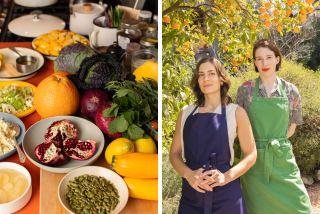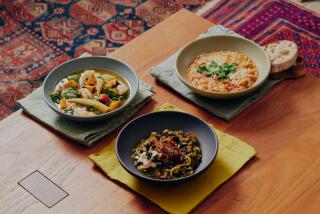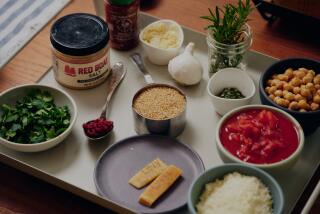The Good Soups of Provence
I have never met a Mediterranean home cook who did not impress me with her soups.
When I lived in France, I spent a fair amount of time at Domaine Tempier, a winery in Bandol that is famous for its wines but also renowned in food circles for the cooking of its proprietress, Lulu Peyraud. I spent the harvest there in 1981, helping Lulu prepare lunches for the grape pickers every day and learning everything I could about Provencal food and Bandol wine.
Lunches were hearty meals that would sustain the workers through the long hot afternoons (I, on the other hand, required a post-prandial siesta). In the evenings Lulu always made a soup; sometimes it was a very light garlic soup or tomato soup with pasta; other times it was a more robust soupe au pistou, the Provencal vegetable and bean soup that is embellished before serving with a basil pesto (called pistou in Provencal).
Soupe au pistou is the signature spring/summer soup of Provence, particularly along the Riviera, where basil is abundant (and is often referred to as “pistou”). As you move east into Italy the name changes to minestrone, which is just an emphatic word for minestra, the Italian word for soup. On hot summer days cooks make minestrone in the morning, let it cool and serve it cold at midday.
There are many minestrones-winter versions and summer versions, minestrones based on something simple like cabbage or lentils or beans, or more elaborate combinations of beans and vegetables. The one thing all minestrones have in common is the fact that they are always a thick and filling mixture of vegetables, beans and pasta or rice. And they taste better with time.
Meat stock can be used for a more robust-tasting soup, but it is not a requirement. In the spring and summer, when the vegetables are so sweet and fresh, I prefer using water to get a broth that is the essence of vegetables. I have never met a French or Italian home cook that did it any other way. The one item that is essential to a richly flavored broth, and it is used in soups on both sides of the French-Italian border, is a rind or two of Parmesan cheese, which is included in the bouquet garni.
When I was researching Provencal soupe au pistou in France, each person I spoke with, and each cookbook author I read, was sure that his or her version of the dish was the true, authentic soup, la vraie. Many cooks insisted that the real soup could only be made in spring and summer, when fresh cranberry beans, green beans and tomatoes were available; they would never use dried beans. Still others used dried beans for the soup. I find that dried beans are an important ingredient, because their savory broth contributes much to the flavor of soupe au pistou. If I can find fresh beans, I am delighted for the addition, but their lack of availability does not mean I’m not going to make the soup.
Italian minestrones invariably begin with a long, gentle simmer of aromatic vegetables-onion, carrot, celery, garlic-in olive oil; sometimes a small amount of pancetta or butter is added. The amount of olive oil varies widely, from a couple of tablespoons (which is what I use) to half a cup. Once the aromatics have cooked down, the remaining vegetables and water or broth are added, the mixture is brought to a boil, the heat reduced and the soup simmers for an hour or more. Cooked dried beans are added toward the end of cooking, along with the pasta or rice that will enrich the soup.
In Provence, on the other hand, I found that most cooks simply throw all of the ingredients into a pot, let the mixture simmer for an hour or two, add pasta, and serve the soup when the pasta is cooked, adding the enrichment at the end, in the form of the heady pesto. This is a very relaxing way to make a soup. You can prepare the vegetables one at a time, adding them to the pot of water as they are ready.
I do one thing differently than traditional cooks. To have a more colorful soup, I hold back half of the green vegetables-the green beans, peas, zucchini-and blanch or steam them separately, adding them just before I serve the soup so that they can heat through, but still retain their bright green hue.
Not all great spring soups require as much time and effort as a minestrone or soupe au pistou. The easiest soup on earth is garlic soup, and this is a great time of year for it, because you can use fresh garlic and embellish it with bright peas, sugar snap or English, green beans or favas.
So just because the weather is turning warm and the days are lengthening, don’t forget about soups. Spring markets offer up a gold mine for light soups and robust minestrones, sparkling with produce, their broths the sweet outcome of a long slow simmer of many aromatic vegetables.
* Shulman is author of “Mediterranean Light” and “Provencal Light” (both published by William Morrow).
* Napkins, tray and bowls from Pier 1 stores.
Minestrone
Active Work Time: 1 hour * Total Preparation Time: 2 1/2 hours * Vegetarian
There are many versions of minestrone. Some call for meat stock, some, like this, rely on plain old water. Like all “big soups,” this one will taste even better the day after you make it.
2 tablespoons olive oil
2 onions, chopped
2 large or 3 medium leeks, white and light green parts only, cleaned and sliced
2 carrots, chopped
2 stalks celery, chopped
Salt
1/2 small head green or savoy cabbage, shredded (about 4 cups)
6 large cloves garlic, minced or pressed
2 quarts water
2 boiling potatoes, diced
2 turnips, peeled and diced
1 (14-ounce) can tomatoes, with liquid, seeded and chopped
1/2 pound green beans, cut into 1-inch lengths (about 2 cups), divided
1 teaspoon chopped fresh oregano or 1/2 teaspoon dried
1 (2 1/2 x 1 1/2-inch) piece Parmesan rind
1 bay leaf
Few sprigs each thyme and parsley
1 pound fresh fava beans, shelled
1 cup fresh peas or frozen peas, thawed
1 (15-ounce) can cannellini or borlotti beans, drained and rinsed
1/4 pound turnip greens or Swiss chard, stemmed, washed well and chopped (about 2 cups)
1/2 cup pasta, such as elbow macaroni, small shells or broken spaghetti
Freshly ground pepper
1/4 cup chopped parsley
1/3 cup freshly grated Parmesan
Heat the oil over medium-low heat in a large, heavy soup pot or Dutch oven and add the onions. Cook, stirring, until they begin to soften, and add the leeks. Cook, stirring, until the vegetables are tender and translucent but not browned, about 5 minutes. Add the carrots and celery and a generous pinch of salt, and continue to cook, stirring often, until the vegetables are tender and fragrant, 5 to 10 minutes. Stir in the cabbage and the garlic, add a little more salt, and cook until the cabbage has wilted, about 5 minutes.
Add the water, potatoes, turnips, canned tomatoes with liquid, half the green beans and oregano and bring to a boil. Tie the Parmesan rind, bay leaf, thyme and parsley sprigs together with kitchen string, or tie in cheesecloth, and add to the pot. Add salt to taste (at least 2 teaspoons), reduce the heat to low, cover and simmer 45 minutes.
While the soup is simmering, blanch the remaining green vegetables: Bring a pot of water to a boil, drop in the shelled favas and boil 1 minute. Remove from the water using a slotted spoon or skimmer and transfer to a bowl of cold water. Drain and pop the skins off the favas. Set aside. Bring the water in the pot back to a boil, add a teaspoon of salt and the peas and remaining green beans. Boil until just tender but still bright green, 5 minutes. Remove from the water using a slotted spoon, refresh with cold water and set aside. Retain the cooking water in case you want to thin out the soup later.
Stir the canned beans into the soup, then add the greens and the pasta and simmer until the pasta is cooked al dente, 10 minutes. Stir the cooked peas, favas and green beans into the soup. Grind in some pepper and taste. Does the soup taste vivid? Does it need more salt? (Probably). Or garlic? It should be savory and rich-tasting. Adjust seasonings as necessary. If it seems too thick, thin out with a little cooking water from the green vegetables.
Remove the Parmesan rind bundle, stir in the chopped parsley, and remove from the heat. Serve in wide soup bowls, with a tablespoon of Parmesan sprinkled over the top.
Note: If making the soup ahead, make through step 2, when you have added the peas and green beans. On the day you are serving the soup, bring back to a simmer and proceed with step 3, adding the greens and the pasta.
6 to 8 servings. Each of 8 servings: 315 calories; 585 mg sodium; 9 mg cholesterol; 8 grams fat; 3 grams saturated fat; 47 grams carbohydrates; 18 grams protein; 11.65 grams fiber.
Garlic Soup
Active Work Time: 15 minutes * Total Preparation Time: 45 minutes * Vegetarian
Many culinary traditions have their version of garlic soup. I first tasted it in Mexico; I have eaten it in Spain, and most often, in Provence, where it is considered not only a perfect meal, but a great restorative. “Ago Boudo sauva la vida,” “garlic soup is a life saver,” goes an old Provencal saying. For me, it’s a lifesaver because I know that on any given night when I don’t think I have anything for dinner, I have the ingredients for garlic soup. It’s a great vehicle for spring vegetables, and you can also make it with the marvelous spring garlic that is hitting the markets right now.
6 cups water
3 to 6 large cloves garlic, minced or pressed, or 1/2 cup chopped fresh spring garlic, plus 1 clove garlic cut in half
1 1/2 to 2 teaspoons salt
1 bay leaf
1/4 to 1/2 teaspoon dried thyme, or a few sprigs of fresh, or 2 or 3 fresh sage leaves
4 thick slices country-style bread or French bread
2 eggs, beaten
2 teaspoons olive oil, optional
Freshly ground pepper
2 tablespoons chopped parsley
2 to 4 tablespoons freshly grated Parmesan or Gruyere cheese
Bring the water to a boil in a 3-or 4-quart saucepan or soup pot. Add the minced or pressed garlic, salt, bay leaf and thyme or sage. Reduce the heat, cover and simmer 15 minutes if using regular garlic, 30 minutes if using spring garlic. Taste and adjust salt. Add more garlic if desired.
Toast the bread. As soon as it’s done, rub both sides with the cut clove of garlic and set aside.
Beat together the eggs and olive oil. Spoon a ladleful of the hot soup into the eggs and stir together. Then turn off the heat under the soup, and stir in the egg mixture. The eggs should cloud the soup but they shouldn’t scramble if the soup isn’t boiling. Stir in the pepper and parsley.
Place a garlic crouton in each bowl. Ladle in the soup, sprinkle Parmesan or Gruyere over the top, and serve.
4 servings. Each serving: 133 calories; 1,147 mg sodium; 106 mg cholesterol; 4 grams fat; 2 grams saturated fat; 16 grams carbohydrates; 7 grams protein; 1.02 grams fiber.
Variations
Garlic Soup With Broccoli, Green Beans or Sugar Snap Peas and Peas: Add 1/2 pound broccoli florets, green beans or sugar snap peas, or 1 cup shelled favas or fresh or thawed frozen peas, to the soup at the end of step 1. Simmer 5 to 10 minutes, until the vegetables are tender. They should remain bright. Meanwhile make the croutons. Proceed with step 3.
Garlic Soup With Potatoes: Add 1/2 pound waxy or moderately waxy potatoes, such as Yukon Gold, fingerlings or white creamers, scrubbed and sliced about 1/4 inch thick, to the soup at the beginning of step 1. By the end of the 15 minutes they should be tender. If they are not, continue to simmer until they are tender and proceed with the recipe.
Garlic Soup With Pasta: Add pasta such as small shells or elbow macaroni, or large pasta such as fusilli to the soup at the end of step 1. Cook the pasta al dente, then check again for salt, and proceed with the recipe.
Note: You can add green vegetables to the potato or pasta version. Add them at the end of step 1 as directed.
Provencal Soupe au Pistou
Active Work Time: 1 hour * Total Preparation Time: 2 1/2 hours plus 6 hours standing * Vegetarian
This big spring vegetable soup from Provence is much like an Italian minestrone, but the enrichment comes at the end, rather than at the beginning. The difference between pistou and pesto is the consistency-there are no pine nuts in pistou. Sometimes a tomato is added. Beans are another important component of this soup. If you’re lucky enough to find fresh cranberry beans at your farmers market, use them; otherwise, use 2 cups white beans and soak in 2 quarts water. I also prefer to use new potatoes.
PISTOU
2 to 4 large cloves garlic
2 cups tightly packed fresh basil leaves
Salt
1/3 to 1/2 cup extra-virgin olive oil, as needed
1 small tomato, peeled, seeded and chopped, optional
1 cup freshly grated Parmesan, or a mixture of Gruyere and Parmesan
To make the pistou in a food processor, turn on a processor and drop in the garlic. Scrape down the sides of the work bowl, add the basil and salt to taste (1/4 to 1/2 teaspoon) and process until finely chopped. Scrape down the sides once more and turn on the machine. Drizzle in the oil with the machine running, then drop in the tomato if using. Process to a paste. Taste and add more salt, if necessary. Stir in the Parmesan. To make the pistou in a mortar and pestle, pound the garlic with the salt to a paste. Add the basil, a handful at a time, and pound and grind the basil to a paste. Add the optional tomato and work to a paste with the basil. Drop by drop, work in the olive oil. Stir in the cheese.
SOUP
1 cup white beans, soaked 6 hours or overnight in 1 quart water, then drained
4 quarts water, divided
1 large onion, chopped
6 to 8 large cloves garlic, minced or pressed, divided
A bouquet garni made with a few sprigs each thyme and parsley, a Parmesan rind and a bay leaf, wrapped in cheesecloth and tied with string
1/2 pound green beans or 1/4 pound green beans and 1/4 pound yellow wax beans, trimmed and broken into 1-inch pieces (about 2 cups), divided
2 zucchini (about 1/2 pound), diced, divided
1 pound fresh cranberry beans, shelled
2 large carrots, chopped
2 stalks celery, chopped
2 leeks, white and light green parts only, cleaned and sliced
2 turnips, peeled and diced
1 pound boiling potatoes, diced
1 pound tomatoes, peeled, seeded and chopped, or 1 (14-ounce) can, with liquid
Salt
1/2 cup pasta, such as macaroni or small shells
Freshly ground pepper
1/2 cup grated Parmesan or Gruyere, for sprinkling
Combine the drained white beans and 2 quarts water, and bring to a boil. Skim off any foam, then add the onion, 2 garlic cloves and the bouquet garni. Bring to a boil, reduce the heat, cover and simmer 1 hour.
Add the remaining 2 quarts water, the remaining garlic, half the green beans, half the zucchini, the cranberry beans, carrots, celery, leeks, turnips, potatoes and tomatoes and their liquid to the pot and bring to a boil. Add salt to taste (be generous), reduce the heat, cover and simmer 1 hour. Taste and adjust the seasonings.
While the soup is simmering, blanch or steam the remaining green beans and zucchini until tender but bright, about 5 to 8 minutes, and set aside.
Add the pasta to the soup about 10 minutes before serving and simmer until cooked al dente. Add pepper, and taste and adjust the salt. Stir the blanched or steamed green vegetables into the soup and heat through.
To serve, either stir the Pistou into the pot, place a dollop on each bowl and stir in or pass the Pistou in a bowl and let people stir in their own. Pass additional Parmesan or Gruyere for sprinkling.
Note: If making the soup ahead, make through step 3, when you have simmered the vegetables for an hour. On the day you are serving, bring the soup to a simmer and proceed with preparing then adding the remaining green beans and zucchini.
10 to 12 servings. Each of 12 servings: 263 calories; 467 mg sodium; 10 mg cholesterol; 10 grams fat; 3 grams saturated fat; 32 grams carbohydrates; 13 grams protein; 7.84 grams fiber.
More to Read
Sign up for The Wild
We’ll help you find the best places to hike, bike and run, as well as the perfect silent spots for meditation and yoga.
You may occasionally receive promotional content from the Los Angeles Times.






